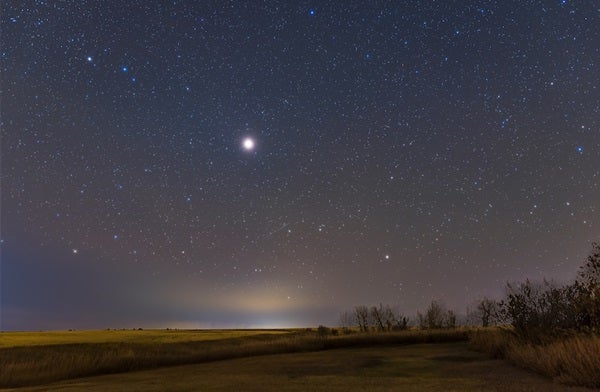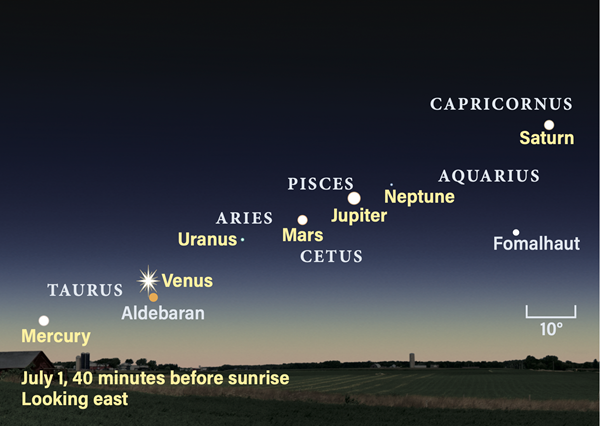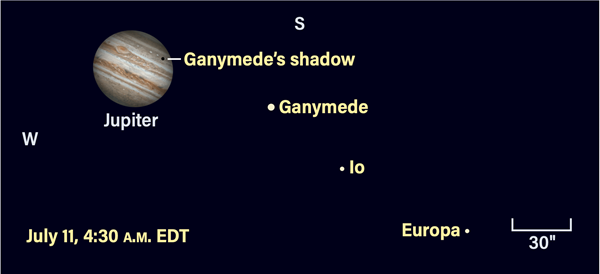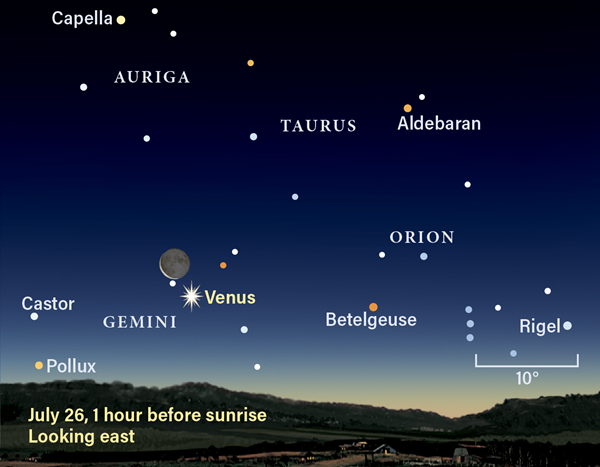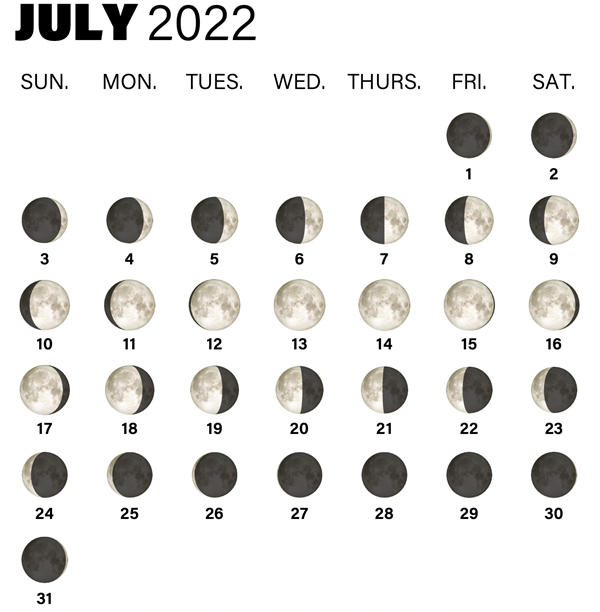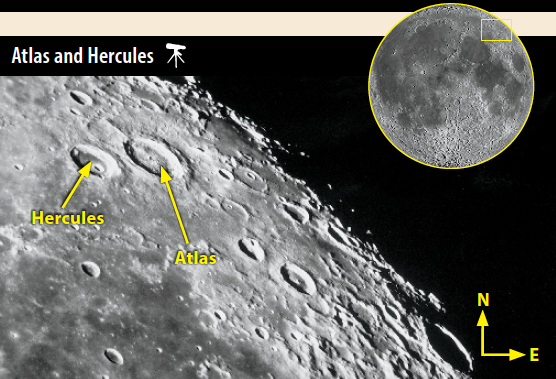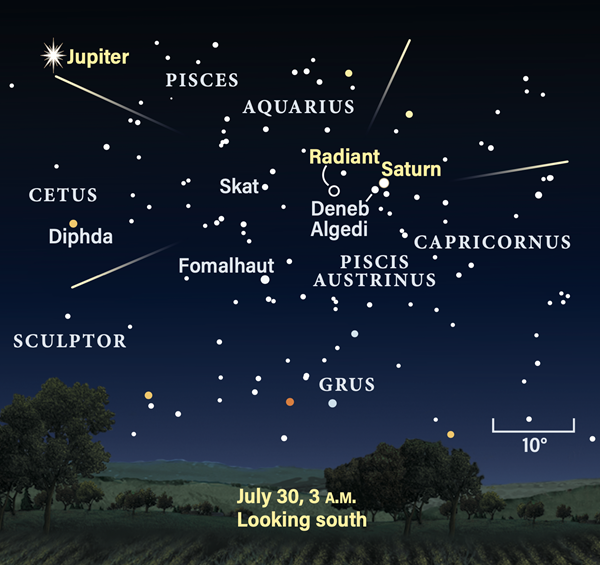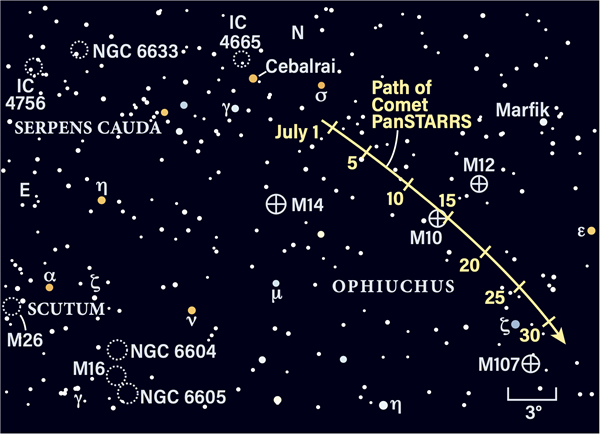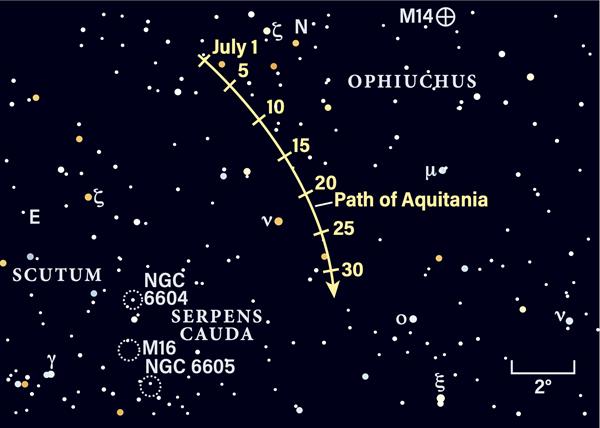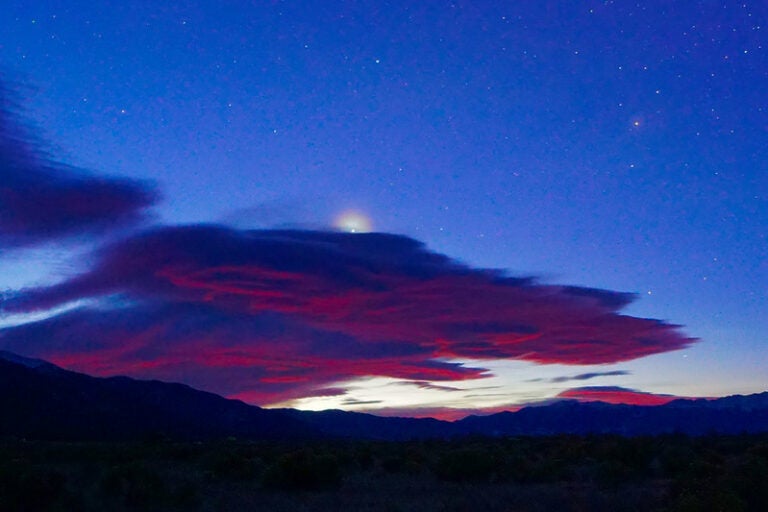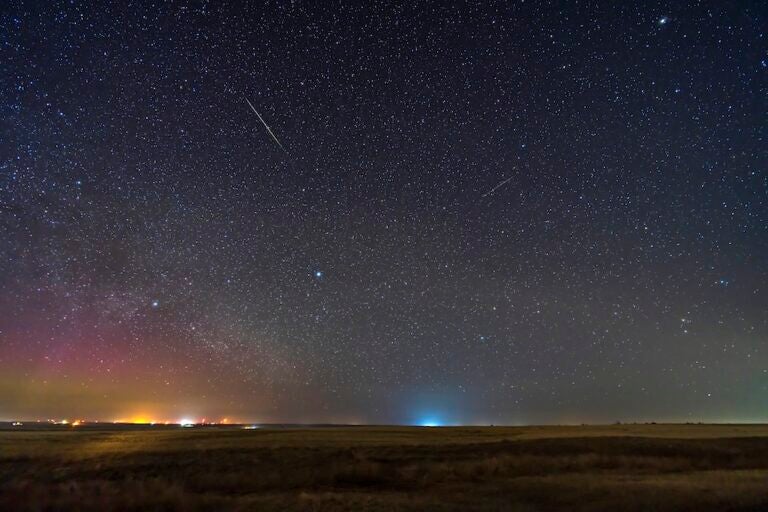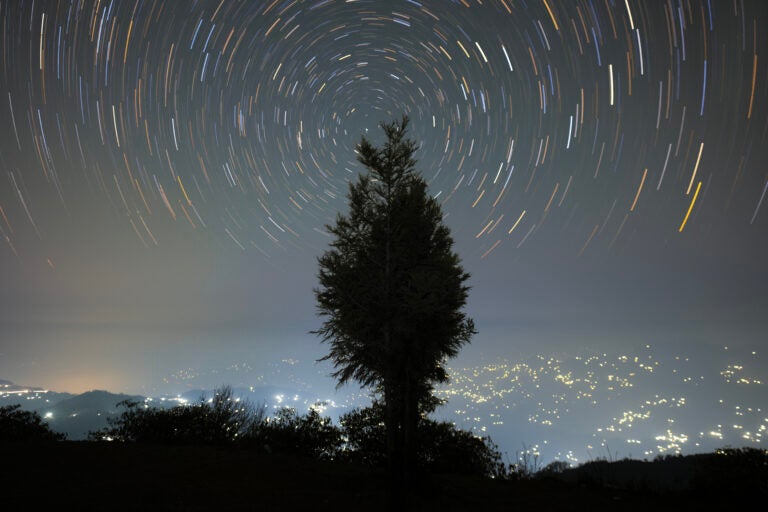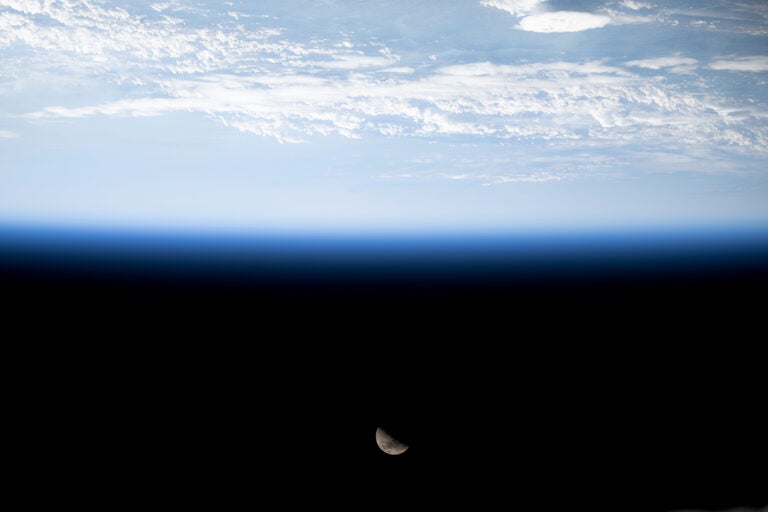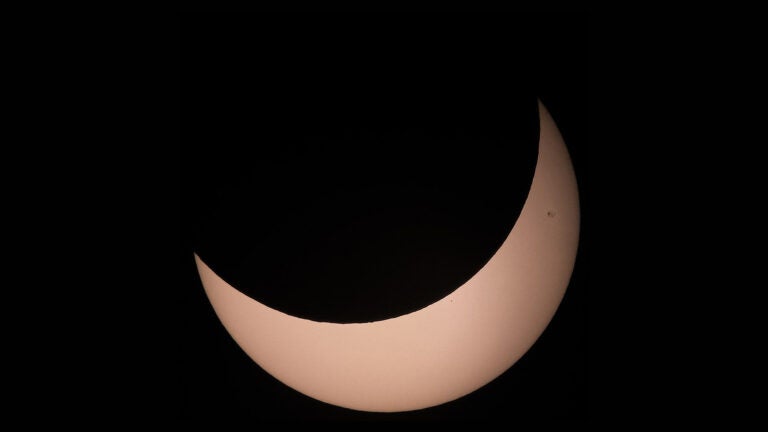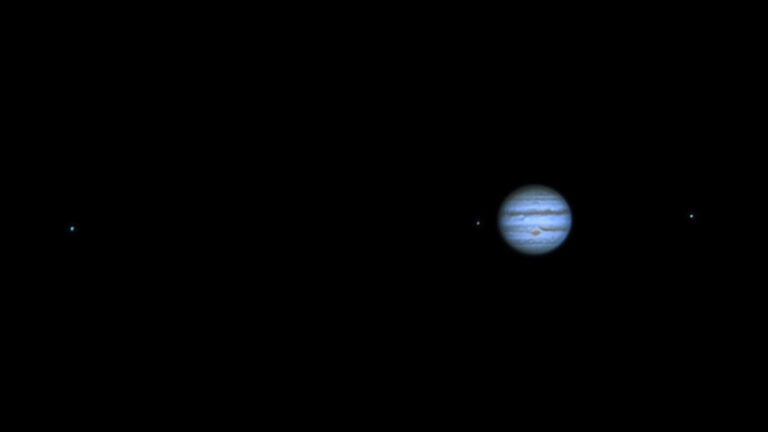We will begin with a brief look at the array of planets on the morning of July 1 before moving to our traditional journey from evening to morning sky. Moving in order from the eastern horizon to high in the southern sky, you can spot Mercury, Venus, Uranus, Mars, Jupiter, Neptune, and Saturn in early July as dawn approaches. They stretch 118° along the ecliptic, through the constellations Taurus, Aries, Pisces, Aquarius, and Capricornus.
Mercury will drop quickly from the morning sky. Try to spot the magnitude –0.8 planet 30 minutes before sunrise on July 1, when it stands 6° above the eastern horizon from mid-northern latitudes. Even though Mercury brightens in the first few days of July, its angular separation from the Sun shrinks each day and it becomes harder to spot in growing twilight. By July 5, it is magnitude –1.1 and only 4° high 30 minutes before sunrise. It heads for superior conjunction on the 16th and then passes into the evening sky. More on Mercury shortly.
Venus stands 13° west of Mercury on July 1, nicely located north of 1st-magnitude Aldebaran in Taurus the Bull. Farther west along the ecliptic, Uranus lies in southern Aries, midway between Venus and Mars. Its magnitude 5.9 glow is hidden from direct view but reachable with 7×50 binoculars.
Mars stands just over 40° west of Venus and is 40° high in the east. It glows dull orange at magnitude 0.4. Less than 20° west of Mars, Jupiter is a brilliant magnitude –2.4. Another binocular planet, Neptune (magnitude 7.7) sits at the boundary of Pisces and Aquarius. Last is Saturn in the southern sky at magnitude 0.4.
Now let’s return to the evening sky and progress until morning, watching each planet rise and checking out its details with a telescope.
First is Mercury, which earlier we found in the eastern sky before dawn. On the 16th, it passes around the far side of the Sun (superior conjunction) and moves into the evening sky.
You might finally spot Mercury July 25, when it is 10° east of the Sun and sets 40 minutes after our star. Try spotting it shining at magnitude –1.2 just 2° high, 25 minutes after sunset. Visibility doesn’t greatly improve due to the shallow angle of the ecliptic to the western horizon this time of year. A favorable opportunity does occur July 29, when Mercury stands 2.7° below the crescent Moon. Find the Moon by 8:30 P.M. local time and search for Mercury slightly below and to its left.
On the last day of July, try to spot Regulus, Leo’s brightest star, in the western sky. Mercury glows 5° to its lower right. Begin around 8:40 P.M. local time — you have about 20 minutes before the pair descends into the evening haze.
Saturn is next to appear, rising in the east just before 11 P.M. local time on July 1. It’s approaching opposition and moving west (retrograde) against the background stars. Now is a great time to view the ringed planet. During the month, it brightens to magnitude 0.3 and remains less than 2° from Deneb Algedi, a 3rd-magnitude star in northeastern Capricornus. You’ll find Saturn 6° northeast of a waning gibbous Moon late on the 15th.
Saturn offers a spectacular view through any telescope. Its ring system is visible with even a small scope, effectively doubling the 18″ size of the planet’s disk. The rings have narrowed since last summer, now tilted by just under 13° to our line of sight. This apparent tilt will increase a few degrees through the fall due to the orientation of Earth’s orbital path relative to Saturn. Despite this, we are now moving toward the 2025 ring plane crossing, when the rings will appear edge-on.
Small scopes will spy Titan, Saturn’s largest moon — an easy target at magnitude 8.5. You’ll find it north of Saturn July 4/5 and 20/21, and due south July 11/12 and 27/28.
Much closer to the planet are the fainter moons Tethys, Dione, and Rhea. They shine at 10th magnitude and orbit with periods ranging from two to five days. Their constantly changing aspect is fascinating to follow.
Neptune has crossed into Pisces after many years in Aquarius. It stands 5° due south of Lambda (λ) Piscium, the southeasternmost star in the Circlet of Pisces. Neptune shines at magnitude 7.7. It rises soon after midnight in early July and is well placed in the southeastern sky in the two hours before dawn. You can get its approximate location from Jupiter: Neptune is about 12° west of the gas giant. Neptune will require binoculars or telescope to find its dim bluish disk, which spans a mere 2″.
Jupiter spends the entire month in Cetus and reaches its stationary point July 29. Starting at magnitude –2.4 and brightening by 0.2 magnitude by month’s end, the giant planet is easy to spot. Rising nearly an hour after midnight on July 1 and a just over an hour before midnight by July 31, Jupiter is well placed throughout the morning hours. The best views come closer to dawn, when it is high in the southern sky.
Jupiter’s disk grows in apparent size from 41″ to 45″, offering a wealth of detail even with small telescopes. Look for the dark equatorial belts straddling the equator. The planet’s temperate zones offer subtle features and contain many spots, both dark and bright, which move noticeably within 10 minutes.
The four Galilean moons orbit Jupiter every two to 16 days, offering a constantly changing display as they and their shadows transit Jupiter’s disk. There are two nice events this month involving Jupiter’s largest moon, Ganymede. On the morning of July 4, Ganymede transits across the disk, starting at 4:41 A.M. CDT (already bright twilight in the Eastern time zone; East Coast observers can catch the moon’s shadow transiting that morning before 3 A.M. EDT). The next day, July 5, Europa transits beginning at 1:17 A.M. EDT.
A similar event takes place one orbit later, on July 11, when Ganymede’s shadow transits starting at 3:55 A.M. EDT. The slow-moving shadow takes just over three hours to cross the planet’s face. The next day (July 12), Europa transits the disk starting at 3:50 A.M. EDT, taking less than two hours to complete its journey.
Io and its shadow traverse Jupiter in a repeating sequence on the mornings of July 8th (from 2:19 A.M. EDT), 15th (from 4:11 A.M. EDT), and 22nd (from 5:02 A.M. CDT — note this is in daylight in the Eastern time zone). July 22nd includes Ganymede reappearing from behind Jupiter at 4:58 A.M. CDT, just before Io’s transit begins. Io joints its own shadow for a transit July 31st at 2:20 A.M. EDT.
Callisto is far enough out that the slight tilt in its orbital plane relative to Earth causes it to miss Jupiter entirely. On July 17 around 1 A.M. EDT, Callisto lies south of Jupiter’s south pole.
Mars rises among the faint stars of Pisces shortly before 2 A.M. local time on July 1. The planet grows slowly brighter this month, from magnitude 0.4 to 0.2. It starts July 20° east of Jupiter and drifts eastward from night to night. On July 2, the Red Planet lies 13′ due south of 4th-magnitude Omicron (ο) Piscium. Mars crosses into Aries July 9; a waning crescent Moon joins it in the Ram July 21, less than 3° away by sunrise. On July 31, Mars rises soon after midnight and stands 11° north of Menkar, a magnitude 2.5 star in Cetus the Whale.
Mars reveals its 8″-wide face through telescopes and shows a nice 85-percent-lit gibbous disk. You will need lucky moments of steady atmospheric seeing to spot details. High-speed video capture with long-focal-length telescopes and extensive processing will begin to bring out features. Mars reaches opposition in December, when the apparent size of its disk will be more than 2 times larger.
Venus stands 4° due north of Aldebaran, the brightest star in Taurus, before dawn on July 1. It rises about 3:45 A.M. local time and by 4:30 A.M. is well clear of the horizon, adjacent to the stars of the Hyades.
Each morning, Venus slides farther east, passing 24′ north of the Crab Nebula (M1) July 13. Venus then spends three days — July 16 to 18 — crossing the extreme northern edge of Orion before moving into Gemini the Twins. The glowing planet sits 1.5° south of the open star cluster M35 on July 20. A very fine waning crescent Moon stands less than 4° north of Venus on July 26 — a glorious early-morning display just as Castor and Pollux, Gemini’s twin 1st-magnitude stars, rise to greet the dawn.
Through a telescope, Venus changes from an 86-percent-lit disk spanning 12″ on July 1 to 92 percent lit and 11″ wide on July 31. Its magnitude remains a constant –3.9 all month.
Earth reaches aphelion, the farthest point from the Sun in its orbit, on July 4.
A top-down view
Craters at the fringe become easy to enjoy when the Moon reaches its lowest high. Tucked against the northern limb on the west side of the pole lie Brianchon, Pascal, Sylvester, and Cremona.
If they had central peaks, we would see those as bumps in profile, but this quartet appears to have flat floors. Their front and back rims stand out brightly in the stark sunlight because they face us almost directly. The views from the 13th to the 15th are wonderfully 3D because every shadow stretches away from the feature that casts it. Can you pick out two craterlets inside Cremona?
All four craters are named for European mathematicians. The most prominent — and classical — crater well interior of the limb is Pythagoras, perhaps the inspiration for names in this part of the Moon.
This geometry is only possible when we catch the Full Moon close to the bottom of its up-and-down bobbing motion around Earth. The 27.2-day cycle quickly loses synch with the 29.5-day parade of phases each month. From our northern perspective, we are now looking down past the crown of Luna’s head. In about nine years, the summer Full Moon will sit at its maximum above the ecliptic, giving us a view under its chin.
When the Moon is New
A New Moon on July 28 coincides closely with the peak of the Southern Delta Aquariid meteor shower, active from July 12 through Aug. 23 and peaking the morning of July 30. Meteors from this shower tend to be faint and reach less than a dozen per hour from most North American sites, although the zenithal hourly rate (when the radiant is overhead, for locations in the Southern Hemisphere) is predicted at 25 per hour. For northern observers, the radiant — near the star Skat in Aquarius — reaches only 30° elevation at 3 A.M. local time.
Other meteor showers are also occurring, though at low rates, but their combined frequency makes moonless mornings late this month favorable. The Perseids begin their slow buildup at the end of July and, with a Full Moon next month during their peak, late July and early August are good times to spot the first members of this shower.
Comet Search: Two-eyed nights
All summer long, Comet C/2017 K2 (PanSTARRS) glows in binoculars just west of the magnificent Milky Way. It’s a perfect time to get (re)acquainted with the bright deep-sky objects that just miss the prime dark observing region along our galaxy’s spine.
Start at magnitude 2.8 Beta (β) Ophiuchi; PanSTARRS lies one binocular field southwest. Now swing back to Beta and take in the large star cluster IC 4665 at 10 o’clock. Closer to Aquila are NGC 6633 and IC 4756, set against a rich starry background.
Compare the comet to globular clusters M10 and M12. PanSTARRS will be less than 1° from M10 from the 13th to the 15th, sadly with a nearly Full Moon in the sky. Still, don’t let that stop you from trying to spot it from the suburbs with a 6-inch scope. PanSTARRS will be a smidge fainter than M12’s magnitude of 6.1 and M10’s 6.6, but comets can have outbursts so we might be in luck. Dark skies return the weekend of the 22nd, when you can compare with M107 (magnitude 7.9). Globulars are generally very round, but the comet’s stubby fan should give it a soft northern flank and well-defined bow on the Sun-facing south.
Locating Asteroids: Hitting the high numbers
The time is right: An asteroid reaches maximum brightness when it is simultaneously closest to the Sun and Earth. Main-belt objects tend to be discovered in order of their size (bigger is brighter), which is why we rarely feature asteroids with numbers above 100. 387 Aquitania has a fairly eccentric, egg-shaped orbit that brings this 60-mile-wide world closer in while Earth is farthest out, causing the asteroid to shine brighter than average.
To spot Aquitania, you’ll need a 3-inch scope from the country or a 6-inch under suburban skies. Though close to the Milky Way, the magnitude 10 dot is cruising in front of the Great Rift, whose dust obscures innumerable background stars. Nu (ν) Ophiuchi serves as a nice magnitude 3.1 starting point. Sweep northeast until you reach Aquitania’s predicted position. Come back a night or two later to see that it shifted. From the 25th to the 29th, Aquitania passes two notable field stars, making this easy.
This space rock was named after the region in France where the observatory that discovered it was located, as astronomers had run out of Greek gods and muses by 1894. Good alignments between Aquitania and Earth occur every nine years, but the best come in almost 100-year intervals. We’re slipping out of phase, so the next issue of Astronomy to highlight Aquitania will be in 2122!

